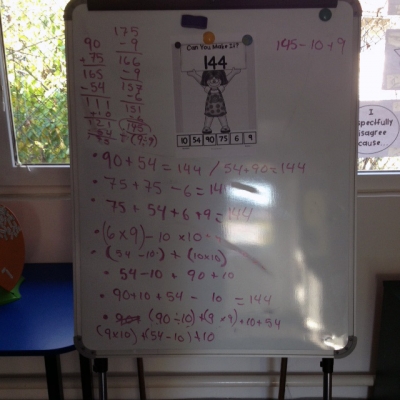This year we decided to add math talks to our daily routine in Grade 4 in order to help our students deepen their understanding of mathematics, realize that there are many valid paths to a solution, and to develop agency for their own learning.
Math, or number talks, as they are also known, are a 10-15 minute routine in which students are given a problem and asked to solve it without using paper or pencil. When a student has a solution, he places one thumb up close to his body, and, for each additional solution, he adds a finger. The reason for not having hands is so that everyone has the same opportunity to think through solutions without the distraction of waving hands. Once everyone has found a solution, students share and build on the ideas of others.
Common language including, “I respectfully disagree” and “I would like to add” were introduced and used regularly during the conversations. Students share strategies and build on the ideas of others. When one student makes a misstep, others will often ask a question or ask the student to clarify his thinking. In fourth grade, we use math talks to look at problems most often that involve numeracy and patterns, but you could use them for any math strand.
Math talks has been an eye-opening experience for both the students and teachers, and we have seen growth in all areas of math. It has been exciting for all of us to recognize that there are many paths to a solution and many ways to “see” mathematics. There have been quite a few “lightbulb” moments during math talks, those exciting times when students explain a concept or idea in a way in which the rest of the class has a collective “Aha!” We have found that these talks help all the students see math as a creative subject in which everyone can have success.
From our first math talks, we noticed that the structure required students to make their thinking visible and justify their understanding clearly by using specific vocabulary. We have also discovered that the connections from previous talks come back and allow students to explain answers that they previously did not understand. The teachers have also been able to identify misconceptions quickly. Overall, we can highly recommend adding math talks to the classroom routines.
More information about math talks can be found:
- https://elementarynumbertalks.wordpress.com/
- https://sites.google.com/site/get2mathk5/home/number-talks
- http://www.visualpatterns.org/
By Julia Denney and Kevin Netzel, Grade 4 Teachers
The International School of Belgrade

